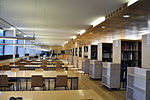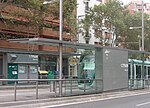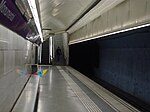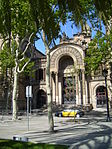Fort Pienc

Fort Pienc (Catalan pronunciation: [ˈfɔɾ piˈɛŋ]) is a neighborhood in the Eixample district of Barcelona, Catalonia, Spain. Its name stems from a former military fortification which existed there until the 19th century called Fort Pius, Pienc is an adjective in Catalan meaning related to the name Pius. There has been a strong Chinese presence in the area since the 2000s. The Arc de Triomf is the main attraction in the area, located in Passeig de Lluís Companys-Passeig de Sant Joan, while L'Auditori is an important concert hall. The National Theatre of Catalonia is another of its cultural centres, as is the General Archive of the Crown of Aragon, near Parc de l'Estació del Nord. The General Catalana de Electricidad building is a fine piece of modernisme or local art nouveau architecture. La Monumental is the only extant bullring in the city.
Excerpt from the Wikipedia article Fort Pienc (License: CC BY-SA 3.0, Authors, Images).Fort Pienc
Carrer de Sardenya, Barcelona
Geographical coordinates (GPS) Address Nearby Places Show on map
Geographical coordinates (GPS)
| Latitude | Longitude |
|---|---|
| N 41.395675 ° | E 2.1837027777778 ° |
Address
Carrer de Sardenya 156
08001 Barcelona (Sant Martí)
Catalonia, Spain
Open on Google Maps











